Identifying Optimal Intensity Measures for Predicting Damage Potential of Mainshock–Aftershock Sequences
Abstract
:1. Introduction
2. Intensity Measures for MS–AS Sequences
3. Structural Damage under MS–AS Sequences
4. SDOF Systems
5. Correlation Analysis
5.1. Selection of MS–AS Sequences
5.2. Correlation Coefficient
6. Effect of Hysteretic Models
7. Empirical Prediction Equations
8. Discussions
9. Conclusions
- (1)
- The correlations between IMMS and DI1MS–AS, IMAS and DI1MS–AS, IM1MS–AS and DI1MS–AS, and IM2MS–AS and DI2MS–AS were examined in the logarithm space for the SDOF systems with varying periods. The results show that the IM-DI pair in terms of IM2MS–AS and DI2MS–AS has the highest correlation among the considered four IM-DI pairs. In other words, the proposed IM, which is defined as IMAS/IMMS, has a better capability to predict damage potential caused by earthquake sequences in comparison with IMMS, IMAS, and IM1MS–AS.
- (2)
- A total of 22 classic IMs were considered as the candidates to define the intensities of MS–AS sequences. Amongst these IMs, IA, vrs, and PGD are the most optimal ones to formulate IM2MS–AS for the acceleration-related, velocity-related, and displacement-related IM groups, respectively, due to the high correlations with DI2MS–AS. There is no single IM to best formulate IM2MS–AS in the entire structural period range. IA,2MS–AS and vrs,2MS–AS are the best IMs before and after a transition period Tc, separately.
- (3)
- A comprehensive parametric study was conducted by considering various types of hysteretic models and different yield reduction factors. The results show that the effects of varying hysteretic models and yielding reduction factors are limited on the correlation between IM2MS–AS and DI2MS–AS. This result reveals that the obtained conclusion in this study is in a general prospect.
- (4)
- A step-wise equation consisting of linear and nonlinear parts was regressed as the median prediction of ρ between the best IM2MS–AS and the caused DI2MS–AS. Moreover, through regression analysis, another step-wise function was developed to denote the standard deviation of the ρ values along with T. The empirical equations can fit the obtained data reasonably well, providing an opportunity for the further studies to conduct a quick prediction of damage potential for a specific MS–AS earthquake sequence.
Author Contributions
Funding
Conflicts of Interest
Abbreviations
| Descriptions | Abbreviation |
| Intensity measure | IM |
| Engineering demand parameter | EDP |
| Damage index | DI |
| Mainshock | MS |
| Aftershock | AS |
| Mainshock–aftershock sequences | MS–AS sequences |
| Yield strength reduction factor | R |
| Peak ground acceleration | PGA |
| Arias intensity | IA |
| Mean-square acceleration | Pa |
| Square acceleration | Ea |
| Root-mean square acceleration | arms |
| Root-square acceleration | ars |
| Characteristic intensity | Ic |
| Riddell acceleration intensity | Ia |
| Peak ground velocity | PGV |
| Mean-square velocity | Pv |
| Potential destructiveness | PD |
| Square velocity | Ev |
| Root-mean square velocity | vrms |
| Root-square velocity | vrs |
| Riddell velocity intensity | Iv |
| Fajfar intensity | IF |
| Peak ground displacement | PGD |
| Mean-square displacement | Pd |
| Square displacement | Ed |
| Root-mean square displacement | drms |
| Root-square displacement | drs |
| Riddell displacement intensity | Id |
| Correlation coefficient | ρ |
References
- Kao, H. The Chi-Chi Earthquake sequence: Active, out-of-sequence thrust faulting in Taiwan. Science 2000, 288, 2346–2349. [Google Scholar] [CrossRef] [PubMed] [Green Version]
- Huang, Y.; Wu, J.; Zhang, T.; Zhang, D. Relocation of the M8.0 Wenchuan earthquake and its aftershock sequence. Sci. China Ser. D Earth Sci. 2008, 51, 1703–1711. [Google Scholar] [CrossRef]
- Chian, S.C.; Pomonis, A.; Saito, K.; Fraser, S.; Goda, K.; Macabuag, J.; Offord, M.; Raby, A.; Sammonds, P. Post earthquake field investigation of the Mw9.0 Tōhoku earthquake of 11th March 2011. In Proceedings of the 15th World Conference on Earthquake Engineering, Lisbon, Portugal, 24–28 September 2012. [Google Scholar]
- Mahin, S.A. Effects of duration and aftershocks on inelastic design earthquakes. In Proceedings of the 7th world Conference on Earthquake Engineering, Istanbul, Turkey, 8–13 September 1980; Volume 5, pp. 677–680. [Google Scholar]
- Aschheim, M.; Black, E. Effects of prior earthquake damage on response of simple stiffness-degrading structures. Earthq. Spectra 1999, 15, 1–24. [Google Scholar] [CrossRef]
- Hatzigeorgiou, G.D.; Beskos, D.E. Inelastic displacement ratios for SDOF structures subjected to repeated earthquakes. Eng. Struct. 2009, 31, 2744–2755. [Google Scholar] [CrossRef]
- Zhai, C.H.; Wen, W.P.; Zhu, T.T.; Li, S.; Xie, L.L. Inelastic displacement ratios for design of structures with constant damage performance. Eng. Struct. 2013, 52, 53–63. [Google Scholar] [CrossRef]
- Amadio, C.; Fragiacomo, M.; Rajgelj, S. The effects of repeated earthquake ground motions on the non-linear response of SDOF systems. Earthq. Eng. Struct. Dyn. 2002, 32, 291–308. [Google Scholar] [CrossRef]
- Hatzigeorgiou, G.D. Ductility demand spectra for multiple near- and far-fault earthquakes. Soil Dyn. Earthq. Eng. 2010, 30, 170–183. [Google Scholar] [CrossRef]
- Hatzigeorgiou, G.D. Behavior factors for nonlinear structures subjected to multiple near-fault earthquakes. Comput. Struct. 2010, 88, 309–321. [Google Scholar] [CrossRef]
- Goda, K.; Taylor, C.A. Effects of aftershocks on peak ductility demand due to strong ground motion records from shallow crustal earthquakes. Earthq. Eng. Struct. Dyn. 2012, 41, 2311–2330. [Google Scholar] [CrossRef]
- Goda, K. Nonlinear response potential of mainshock-aftershock sequences from Japanese earthquakes. Bull. Seism. Soc. Am. 2012, 102, 2139–2156. [Google Scholar] [CrossRef]
- Yaghmaei-Sabegh, S.; Ruiz-García, J. Nonlinear response analysis of SDOF systems subjected to doublet earthquake ground motions: A case study on 2012 Varzaghan–Ahar events. Eng. Struct. 2016, 110, 281–292. [Google Scholar] [CrossRef]
- Zhai, C.; Ji, D.; Wen, W.; Lei, W.; Xie, L.; Gong, M. The inelastic input energy spectra for main shock–aftershock sequences. Earthq. Spectra 2016, 32, 2149–2166. [Google Scholar] [CrossRef]
- Zhai, C.H.; Wen, W.P.; Chen, Z.; Li, S.; Xie, L.L. Damage spectra for the mainshock–aftershock sequence-type ground motions. Soil Dyn. Earthq. Eng. 2013, 45, 1–12. [Google Scholar] [CrossRef]
- Yu, X.; Li, S.; Lü, D.-G.; Tao, J. Collapse capacity of inelastic single-degree-of-freedom systems subjected to mainshock-aftershock earthquake sequences. J. Earthq. Eng. 2020, 24, 803–826. [Google Scholar] [CrossRef]
- Ruiz-García, J.; Yaghmaei-Sabegh, S.; Bojórquez, E. Three-dimensional response of steel moment-resisting buildings under seismic sequences. Eng. Struct. 2018, 175, 399–414. [Google Scholar] [CrossRef]
- Ruiz-García, J.; Marín, M.V.; Teran-Gilmore, A. Effect of seismic sequences in reinforced concrete frame buildings located in soft-soil sites. Soil Dyn. Earthq. Eng. 2014, 63, 56–68. [Google Scholar] [CrossRef]
- Tesfamariam, S.; Goda, K.; Mondal, G. Seismic vulnerability of reinforced concrete frame with unreinforced masonry infill due to main shock–aftershock earthquake sequences. Earthq. Spectra 2015, 31, 1427–1449. [Google Scholar] [CrossRef]
- Liu, Y.; Yu, X.; MA, F. Impact of initial damage path and spectral shape on aftershock collapse fragility of RC frame. Earthq. Struct. 2018, 15, 529–540. [Google Scholar]
- Goda, K.; Salami, M.R. Inelastic seismic demand estimation of wood-frame houses subjected to mainshock-aftershock sequences. Bull. Earthq. Eng. 2014, 12, 855–874. [Google Scholar] [CrossRef]
- Yaghmaei-Sabegh, S.; Panjehbashi-Aghdam, P. Damage assessment of adjacent fixed- and isolated-base buildings under multiple ground motions. J. Earthq. Eng. 2018, 1–29. [Google Scholar] [CrossRef]
- Ghosh, J.; Padgett, J.E.; Sánchez-Silva, M. Seismic damage accumulation in highway bridges in earthquake-prone regions. Earthq. Spectra 2015, 31, 115–135. [Google Scholar] [CrossRef] [Green Version]
- Bertetto, A.M.; Masera, D.; Carpinteri, A. Acoustic emission monitoring of the turin cathedral bell tower: Foreshock and aftershock discrimination. Appl. Sci. 2020, 10, 3931. [Google Scholar] [CrossRef]
- Aloisio, A.; Antonacci, E.; Fragiacomo, M.; Alaggio, R. The recorded seismic response of the Santa Maria di collemaggio basilica to low-intensity earthquakes. Int. J. Arch. Heritage 2020, 1–19. [Google Scholar] [CrossRef]
- Akkar, S.; Ozen, O. Effect of peak ground velocity on deformation demands for SDOF systems. Earthq. Eng. Struct. Dyn. 2005, 34, 1551–1571. [Google Scholar] [CrossRef]
- Alvanitopoulos, P.F.; Andreadis, I.; Elenas, A. Interdependence between damage indices and ground motion parameters based on Hilbert–Huang transform. Meas. Sci. Technol. 2009, 21, 25101. [Google Scholar] [CrossRef]
- Elenas, A. Interdependency between seismic acceleration parameters and the behaviour of structures. Soil Dyn. Earthq. Eng. 1997, 16, 317–322. [Google Scholar] [CrossRef]
- Elenas, A. Correlation between seismic acceleration parameters and overall structural damage indices of buildings. Soil Dyn. Earthq. Eng. 2000, 20, 93–100. [Google Scholar] [CrossRef]
- Elenas, A.; Meskouris, K. Correlation study between seismic acceleration parameters and damage indices of structures. Eng. Struct. 2001, 23, 698–704. [Google Scholar] [CrossRef]
- Yakut, A.; Yılmaz, H. Correlation of deformation demands with ground motion intensity. J. Struct. Eng. 2008, 134, 1818–1828. [Google Scholar] [CrossRef]
- Du, W.; Yu, X.; Ning, C.L. Influence of earthquake duration on structural collapse assessment using hazard-consistent ground motions for shallow crustal earthquakes. Bull. Earthq. Eng. 2020, 18, 3005–3023. [Google Scholar] [CrossRef]
- Van Cao, V.; Ronagh, H.R. Correlation between parameters of pulse-type motions and damage of low-rise RC frames. Earthq. Struct. 2014, 7, 365–384. [Google Scholar] [CrossRef]
- Van Cao, V.; Ronagh, H.R. Correlation between seismic parameters of far-fault motions and damage indices of low-rise reinforced concrete frames. Soil Dyn. Earthq. Eng. 2014, 66, 102–112. [Google Scholar] [CrossRef]
- Kostinakis, K.; Athanatopoulou, A.; Morfidis, K. Correlation between ground motion intensity measures and seismic damage of 3D R/C buildings. Eng. Struct. 2015, 82, 151–167. [Google Scholar] [CrossRef]
- Lucchini, A.; Mollaioli, F.; Monti, G. Intensity measures for response prediction of a torsional building subjected to bi-directional earthquake ground motion. Bull. Earthq. Eng. 2011, 9, 1499–1518. [Google Scholar] [CrossRef]
- Mollaioli, F.; Lucchini, A.; Cheng, Y.; Monti, G. Intensity measures for the seismic response prediction of base-isolated buildings. Bull. Earthq. Eng. 2013, 11, 1841–1866. [Google Scholar] [CrossRef]
- Riddell, R. On ground motion intensity indices. Earthq. Spectra 2007, 23, 147–173. [Google Scholar] [CrossRef]
- Fontara, I.K.M.; Athanatopoulou, A.M.; Avramidis, I.E. Correlation between advanced structure-specific ground motion intensity measures and damage indices. In Proceedings of the 15th World Conference on Earthquake Engineering, Lisbon, Portugal, 24–28 September 2012. [Google Scholar]
- Ozmen, H.B.; Inel, M. Damage potential of earthquake records for RC building stock. Earthq. Struct. 2016, 10, 1315–1330. [Google Scholar] [CrossRef]
- Liu, T.T.; Yu, X.; Lü, D.G. An approach to develop compound intensity measures for prediction of damage potential of earthquake records using canonical correlation analysis. J. Earthq. Eng. 2018, 1–24. [Google Scholar] [CrossRef]
- Elenas, A.; Siouris, I.M.; Plexidas, A. A study on the interrelation of seismic intensity parameters and damage indices of structures under mainshock-aftershock seismic sequences. In Proceedings of the 16th World Conference on Earthquake Engineering, Santiago, MN, USA, 8–13 January 2017. [Google Scholar]
- Kavvadias, I.E.; Rovithis, P.Z.; Lazaros, K.V.; Elenas, A. Effect of the aftershock intensity characteristics on the seismic response of RC frame buildings. In Proceedings of the 16th European Conference on Earthquake Engineering, Thessaloniki, Greece, 18–21 June 2018. [Google Scholar]
- Park, Y.; Ang, A.H.; Wen, Y.K. Seismic damage analysis of reinforced concrete buildings. J. Struct. Eng. 1985, 111, 740–757. [Google Scholar] [CrossRef]
- Kunnath, S.K.; Reinhorn, A.M.; Park, Y.J. Analytical modeling of inelastic seismic response of R/C structures. J. Struct. Eng. 1990, 116, 996–1017. [Google Scholar] [CrossRef]
- Kramer, S. Performance-based design methodologies for geotechnical earthquake engineering. Bull. Earthq. Eng. 2013, 12, 1049–1070. [Google Scholar] [CrossRef]
- Arias, A. A measure of earthquake intensity. In Seismic Design of Nuclear Power Plants; Hansen, R., Ed.; MIT Press: Cambridge, MA, USA, 1970; pp. 438–483. [Google Scholar]
- Housner, G.W. Measures of severity of earthquake ground shaking. In Proceedings of the US National Conference on Earthquake Engineering, Earthquake Engineering Research Institute, Ann Arbor, MI, USA, 18–20 June 1975; pp. 25–33. [Google Scholar]
- Nau, J.M.; Hall, W.J. An Evaluation of Scaling Methods for Earthquake Response Spectra; Technical Report; Department of Civil Engineering, University of Illinois at Urbana: Champaign IL, USA, 1982. [Google Scholar]
- Housner, G.W.; Jennings, P.C. Generation of artificial earthquakes. Eng. Mech. 1964, 90, 113–152. [Google Scholar]
- Housner, G.W. Strong ground motion. In Recent Advances in Earthquake Engineering; Wiegel, R.L., Ed.; Prentive Hall Inc.: Englewood Cliffs, NJ, USA, 1970. [Google Scholar]
- Riddell, R.; García, J.E. Hysteretic energy spectrum and damage control. Earthq. Eng. Struct. Dyn. 2001, 30, 1791–1816. [Google Scholar] [CrossRef]
- Araya, R.; Saragoni, R. Capacidad De Los Movimientos Sísmicos De Producir Daño Estructural; Division of Structural Engineering; Department of Engineering, University of Chile: Santiago, Chile, 1980. [Google Scholar]
- Fajfar, P.; Vidic, T.; Fischinger, M. A measure of earthquake motion capacity to damage medium-period structures. Soil Dyn. Earthq. Eng. 1980, 9, 236–242. [Google Scholar] [CrossRef]
- Ning, C.L.; Cheng, Y.; Yu, X. A Simplified approach to investigate the seismic ductility demand of shear-critical reinforced concrete columns based on experimental calibration. J. Earthq. Eng. 2019, 1, 1–23. [Google Scholar] [CrossRef]
- Vaiana, N.; Sessa, S.; Marmo, F.; Rosati, L. A class of uniaxial phenomenological models for simulating hysteretic phenomena in rate-independent mechanical systems and materials. Nonlinear Dyn. 2018, 93, 1647–1669. [Google Scholar] [CrossRef]
- Aloisio, A.; Alaggio, R.; Köhler, J.; Fragiacomo, M. Extension of generalized bouc-wen hysteresis modeling of wood joints and structural systems. J. Eng. Mech. 2020, 146, 04020001. [Google Scholar] [CrossRef]
- Ancheta, T.D.; Darragh, R.B.; Stewart, J.P. Peer NGA-West2 database. In PEER Report No. 2013-03; Pacific Earthquake Engineering Research Center, University of California: Berkeley, CA, USA, 2013. [Google Scholar]
- Campbell, K.W.; Bozorgnia, Y. NGA-West2 ground motion model for the average horizontal components of PGA, PGV, and 5% damped linear acceleration response spectra. Earthq. Spectra 2014, 30, 1087–1115. [Google Scholar] [CrossRef]
- Zhu, R.; Lu, D.; Yu, X.; Wang, G. Conditional mean spectrum of aftershocks conditional mean spectrum of aftershocks. Seismol. Soc. Am. Bull. 2017, 107, 1940–1953. [Google Scholar]
- Båth, M. Lateral inhomogeneities of the upper mantle. Tectonophysics 1965, 2, 483–514. [Google Scholar] [CrossRef]
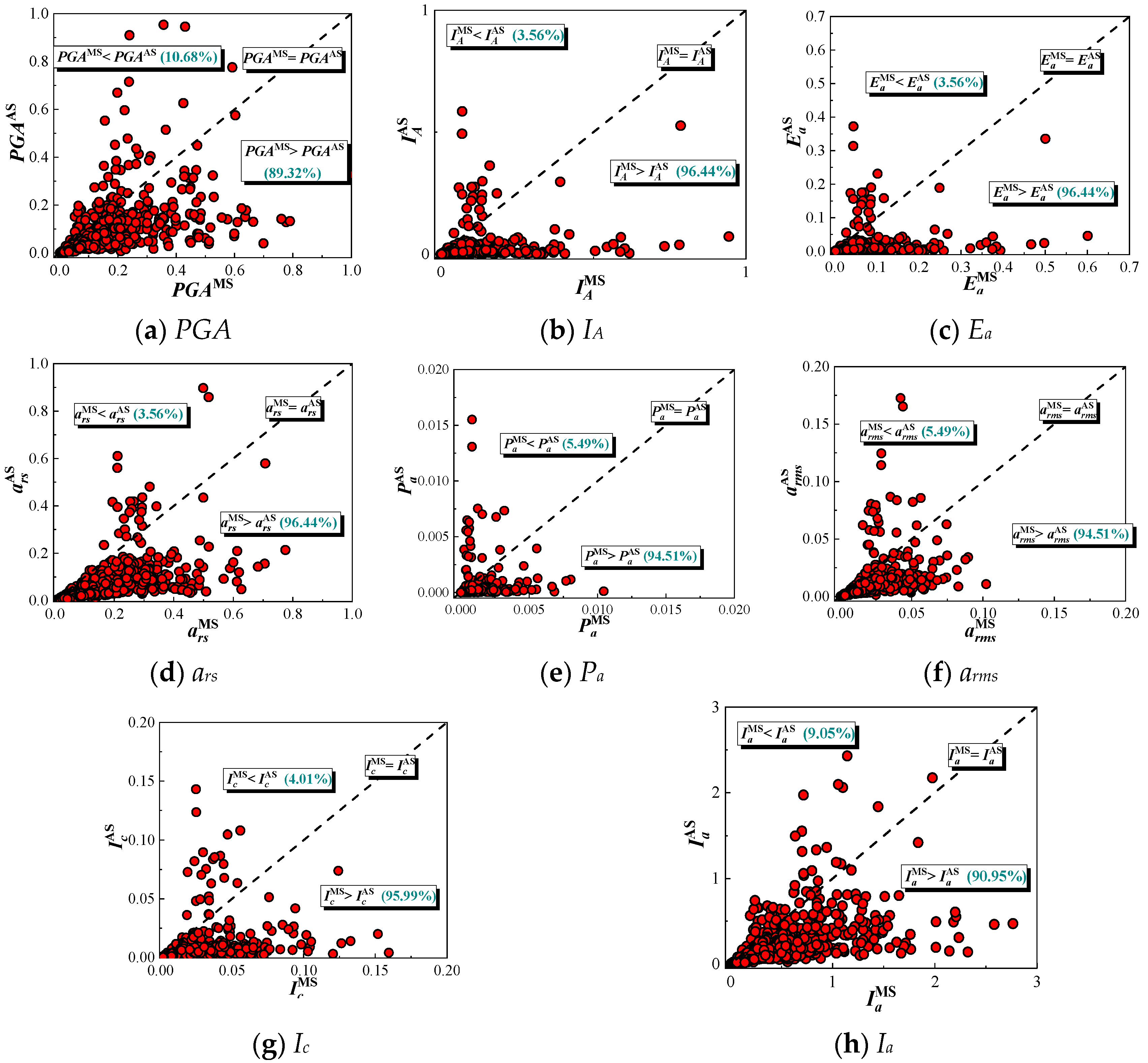
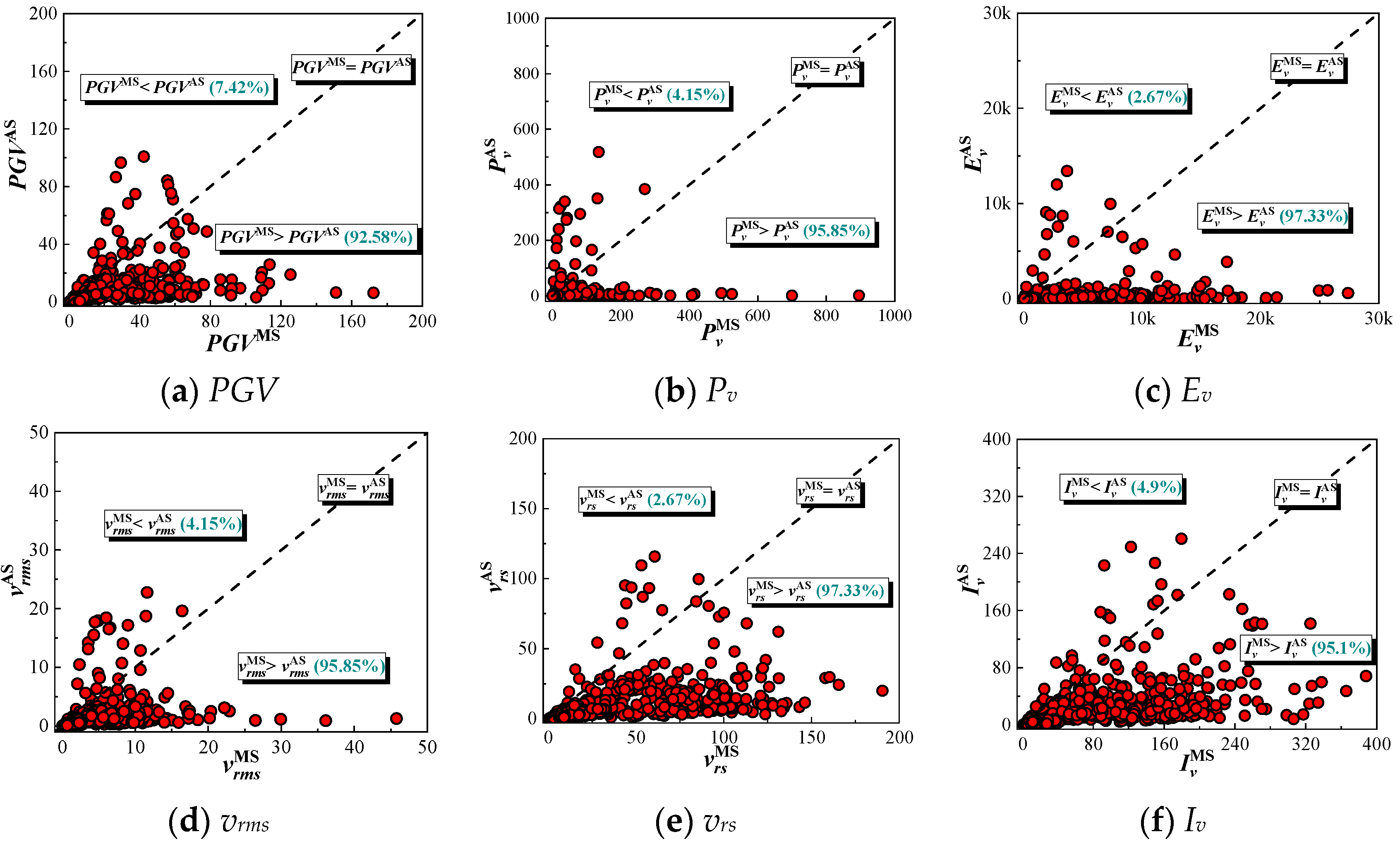
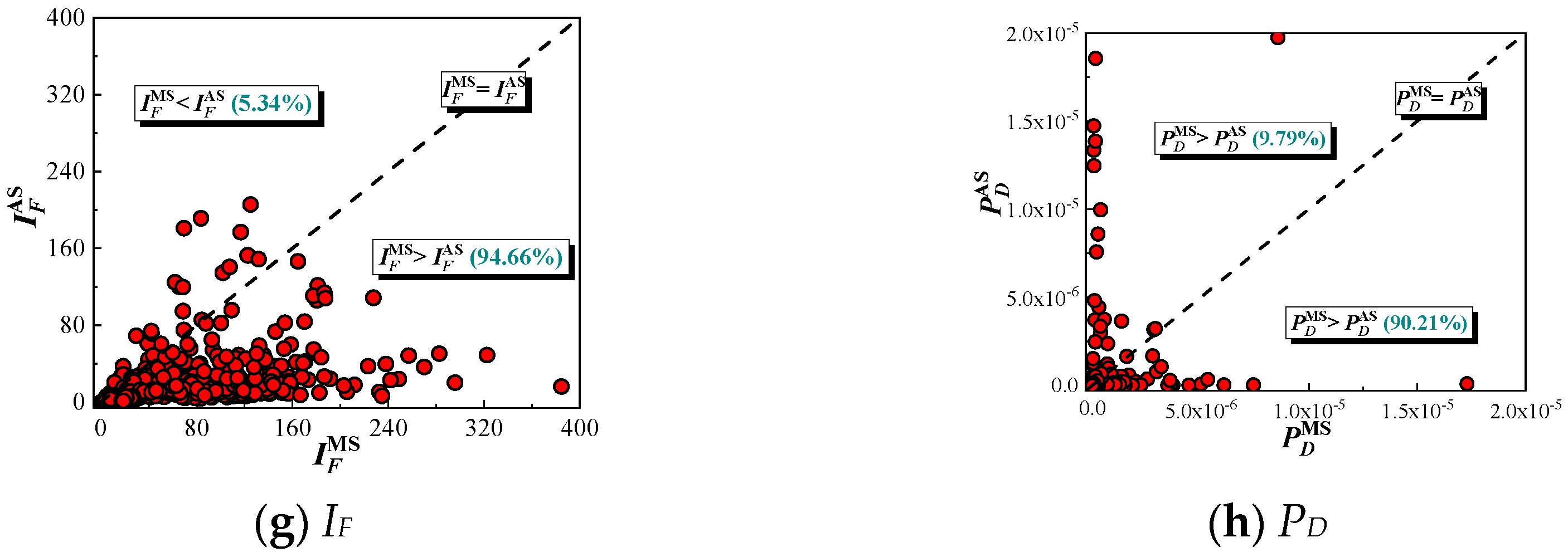


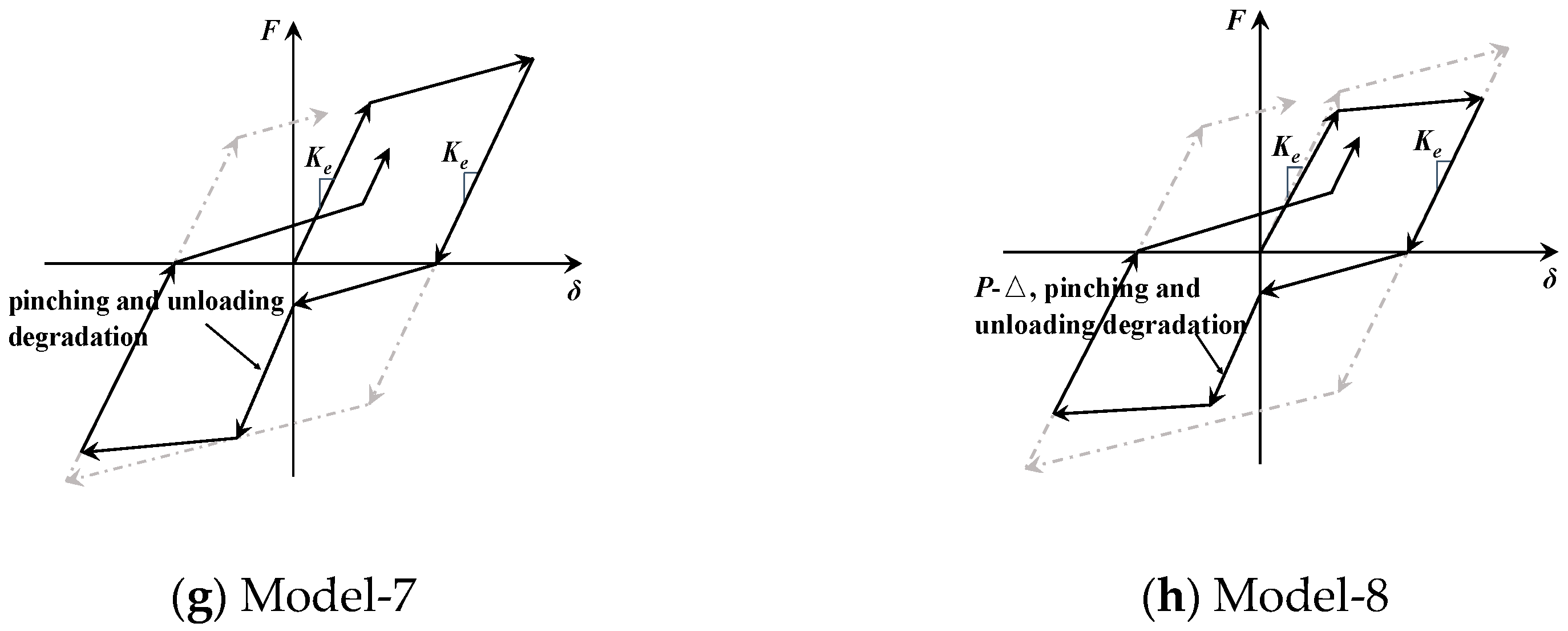
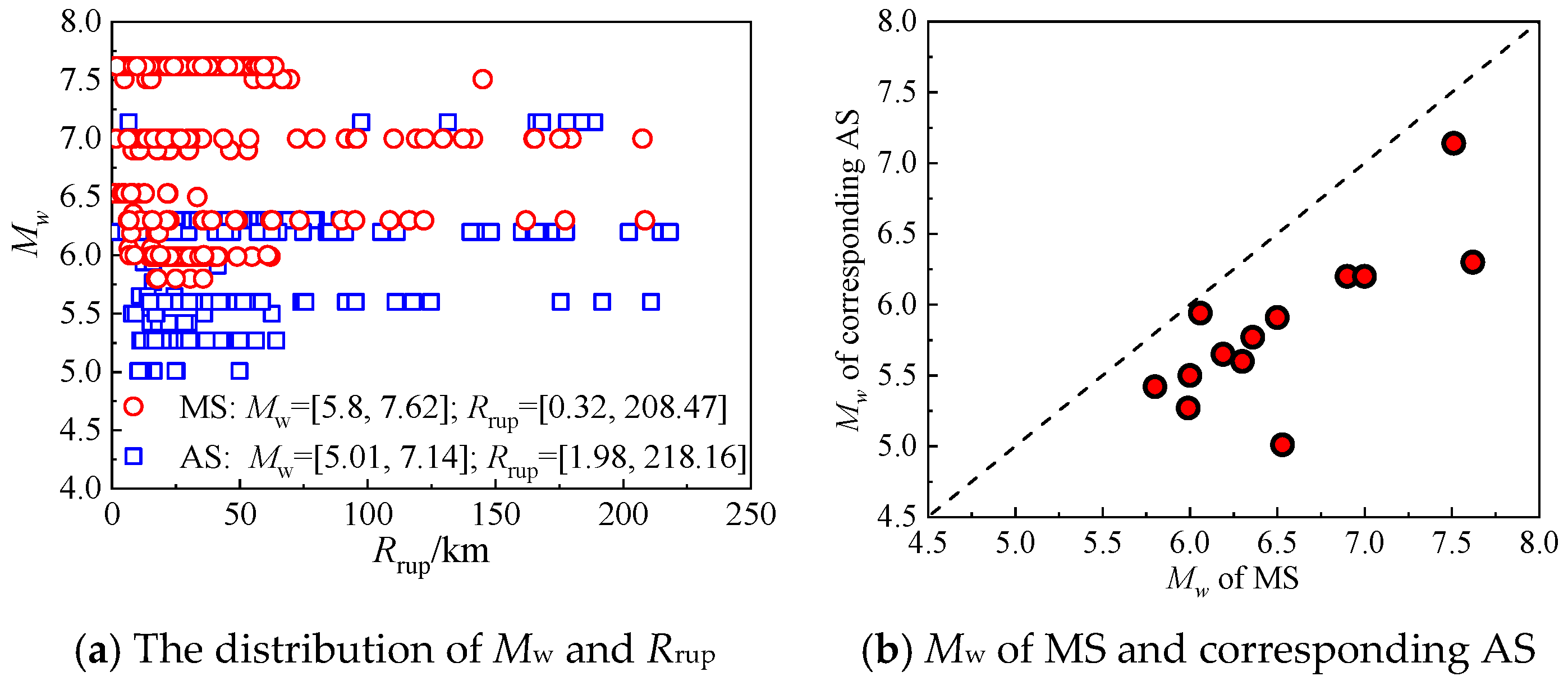





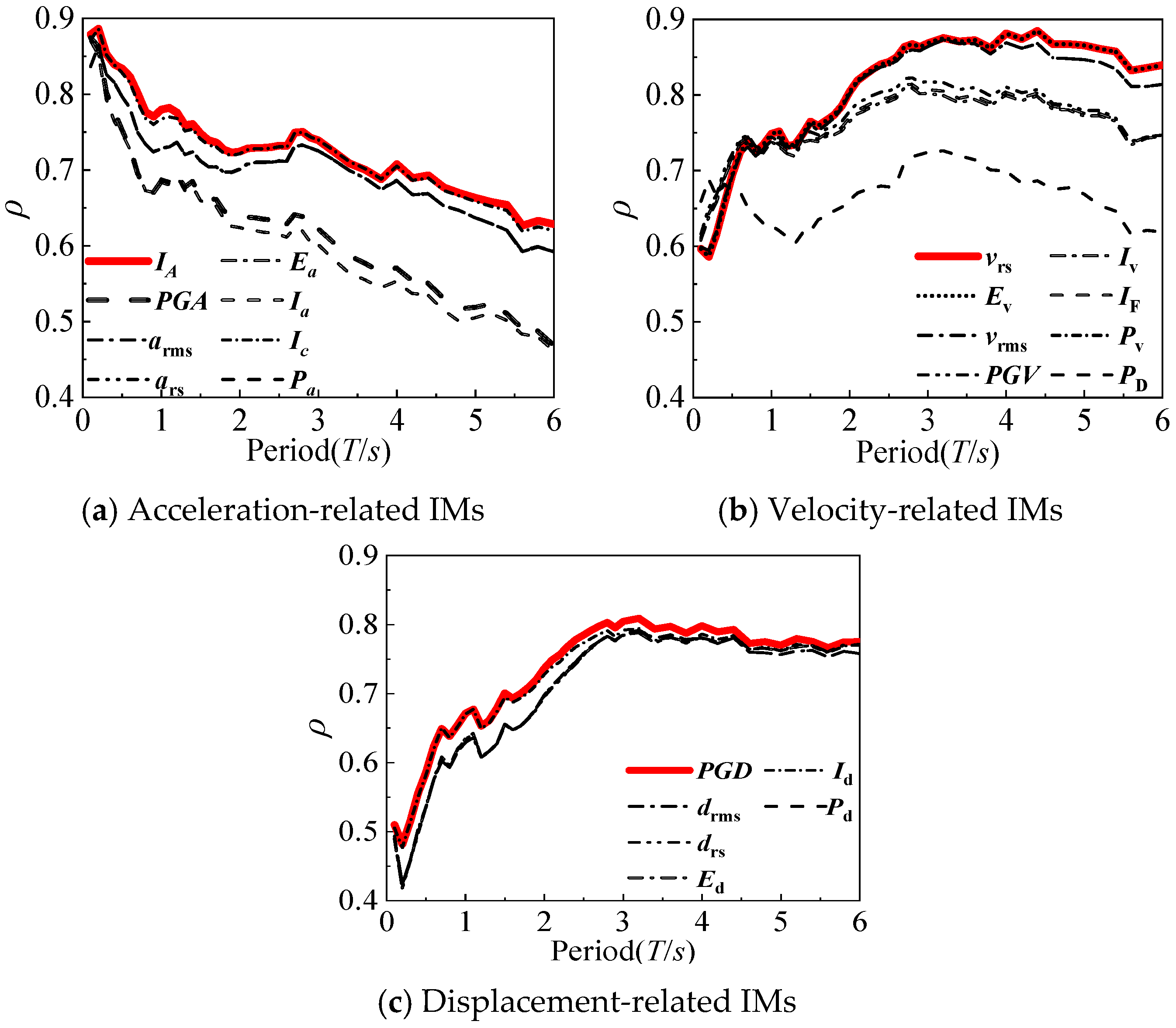
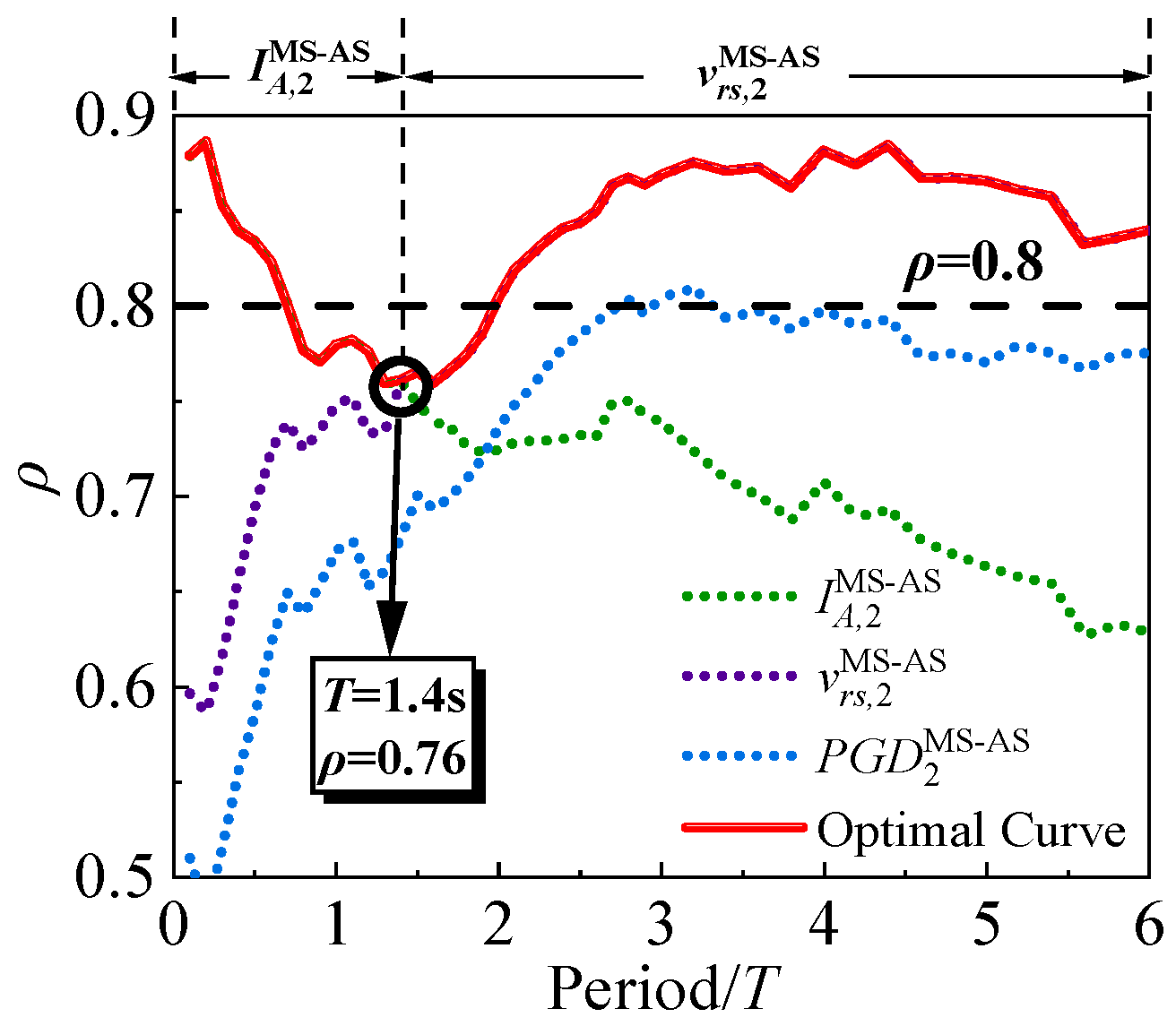
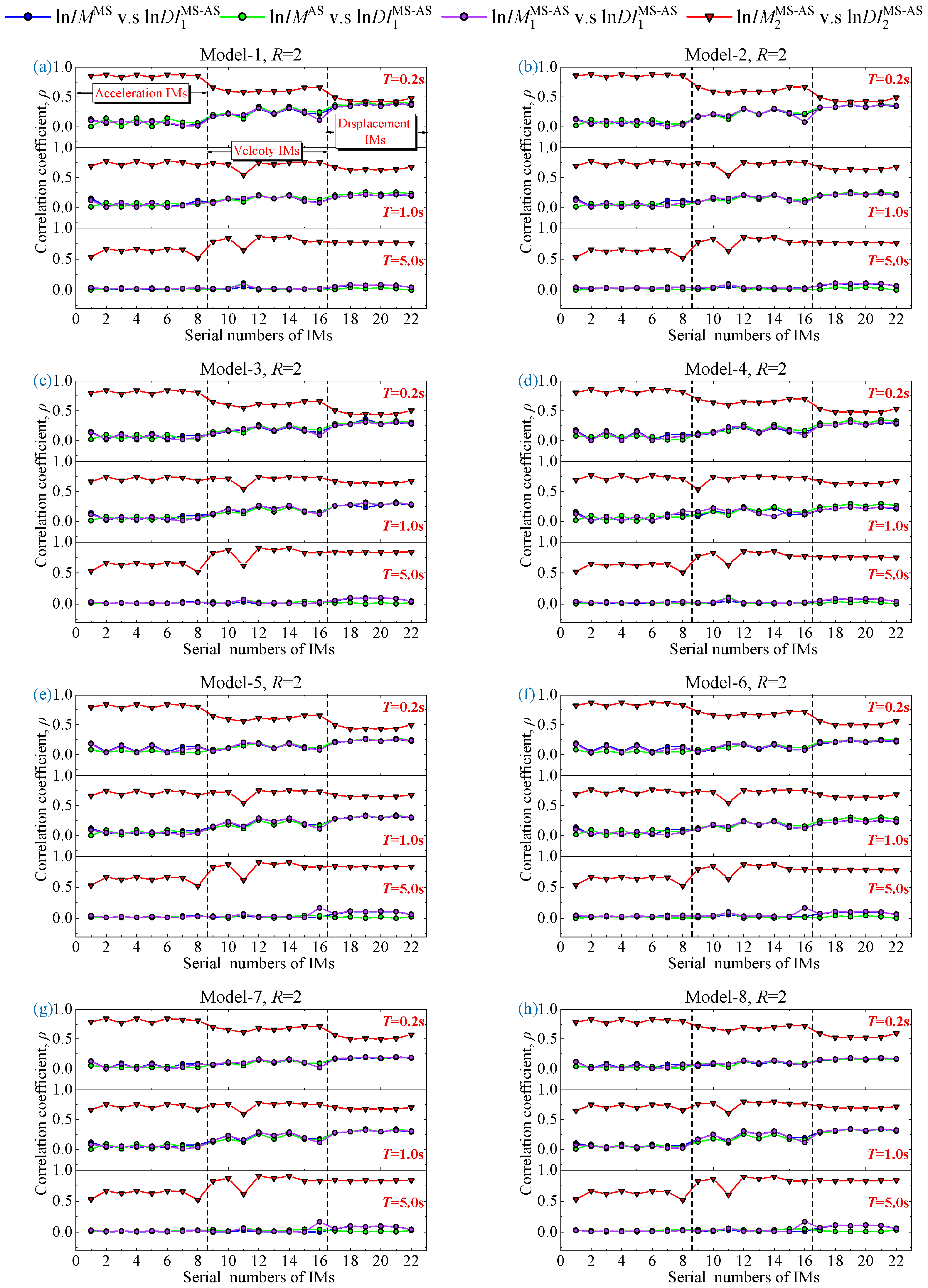
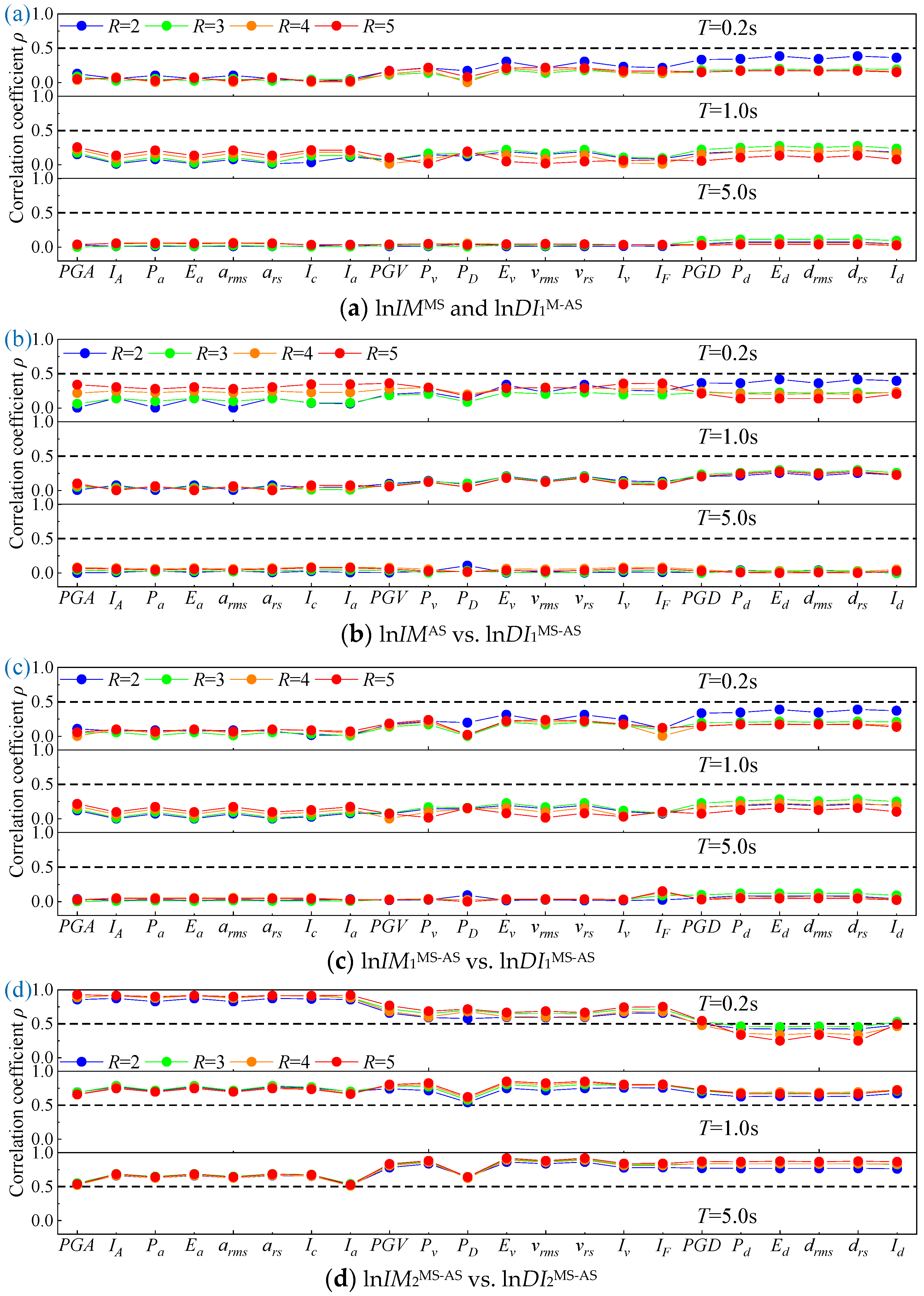
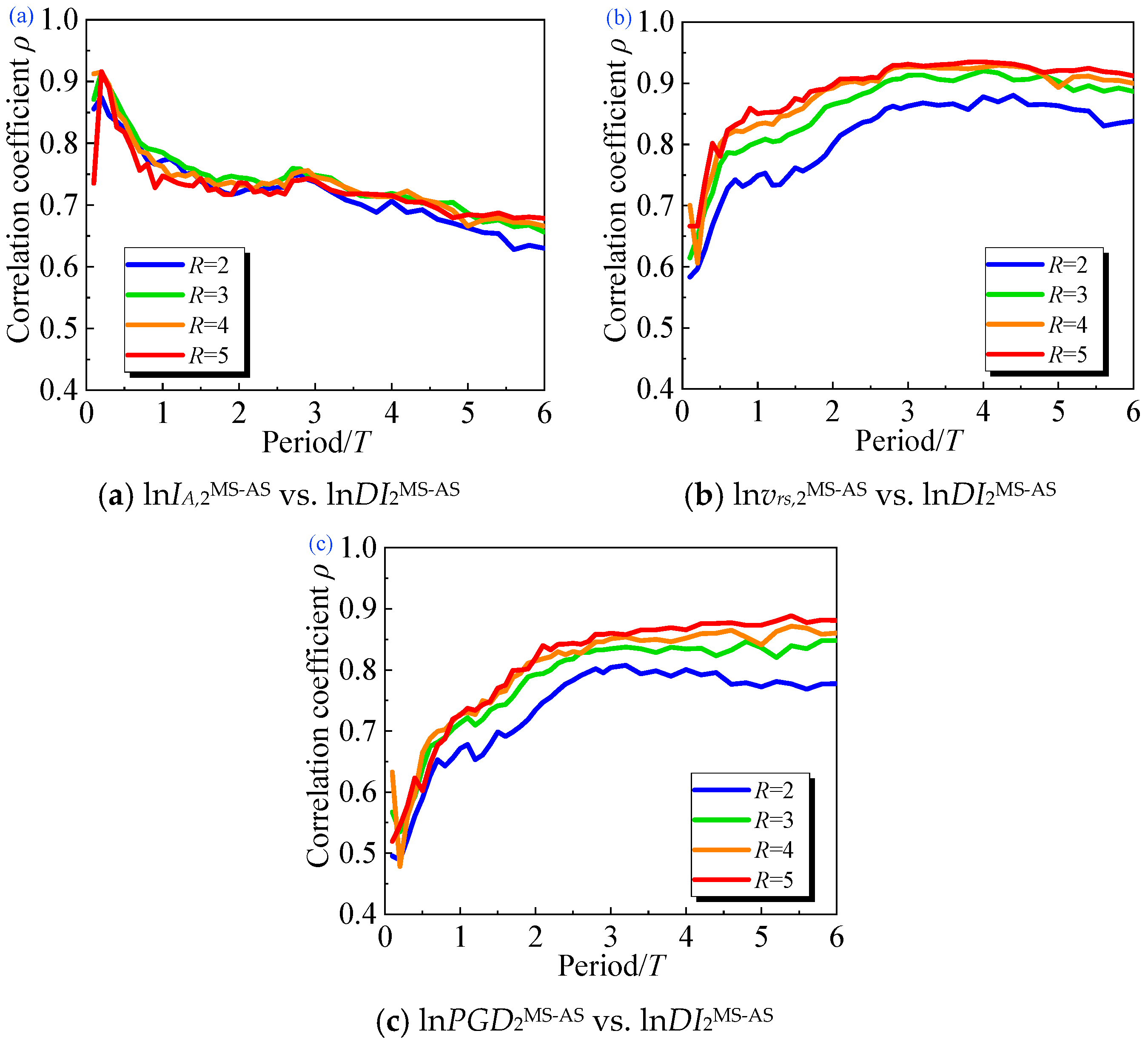

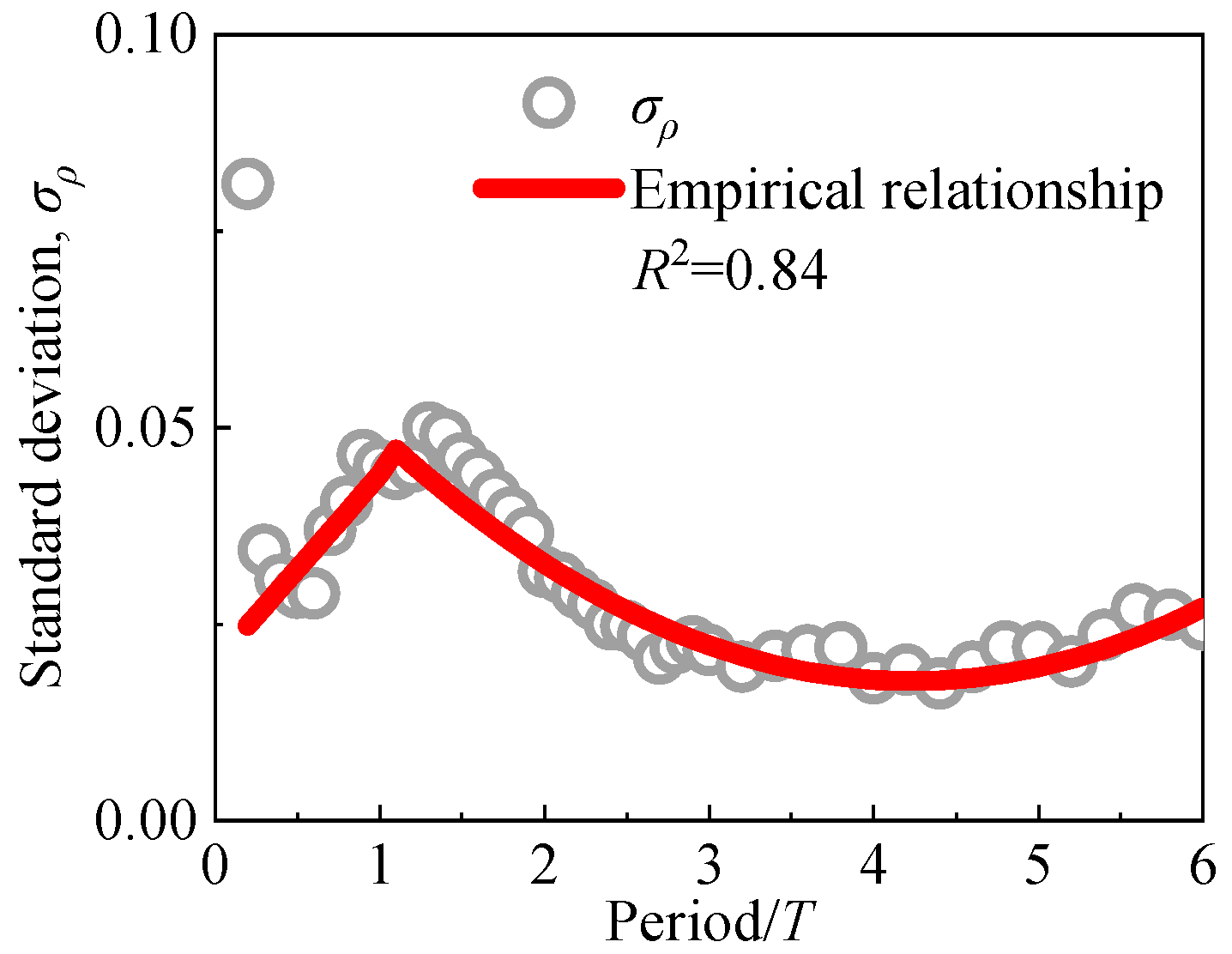

| IMs | ||||
|---|---|---|---|---|
| IMs | ||||
|---|---|---|---|---|
| IMs | ||||
|---|---|---|---|---|
| Ed | ||||
| drms | ||||
| drs | ||||
| Id |
| Delta | PinchX | PinchY | Damage1 | Damage2 | |
|---|---|---|---|---|---|
| Model-1 | 0 | 1.0 | 1.0 | 0 | 0 |
| Model-2 | 0.03 | 1.0 | 1.0 | 0 | 0 |
| Model-3 | 0 | 0.8 | 0.2 | 0 | 0 |
| Model-4 | 0 | 1.0 | 1.0 | 0.05 | 0.02 |
| Model-5 | 0.03 | 0.8 | 0.2 | 0 | 0 |
| Model-6 | 0.03 | 1.0 | 1.0 | 0.05 | 0.02 |
| Model-7 | 0 | 0.8 | 0.2 | 0.05 | 0.02 |
| Model-8 | 0.03 | 0.8 | 0.2 | 0.05 | 0.02 |
© 2020 by the authors. Licensee MDPI, Basel, Switzerland. This article is an open access article distributed under the terms and conditions of the Creative Commons Attribution (CC BY) license (http://creativecommons.org/licenses/by/4.0/).
Share and Cite
Zhou, Z.; Yu, X.; Lu, D. Identifying Optimal Intensity Measures for Predicting Damage Potential of Mainshock–Aftershock Sequences. Appl. Sci. 2020, 10, 6795. https://doi.org/10.3390/app10196795
Zhou Z, Yu X, Lu D. Identifying Optimal Intensity Measures for Predicting Damage Potential of Mainshock–Aftershock Sequences. Applied Sciences. 2020; 10(19):6795. https://doi.org/10.3390/app10196795
Chicago/Turabian StyleZhou, Zhou, Xiaohui Yu, and Dagang Lu. 2020. "Identifying Optimal Intensity Measures for Predicting Damage Potential of Mainshock–Aftershock Sequences" Applied Sciences 10, no. 19: 6795. https://doi.org/10.3390/app10196795
APA StyleZhou, Z., Yu, X., & Lu, D. (2020). Identifying Optimal Intensity Measures for Predicting Damage Potential of Mainshock–Aftershock Sequences. Applied Sciences, 10(19), 6795. https://doi.org/10.3390/app10196795





